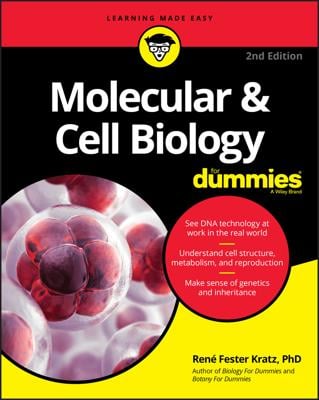Nucleic acids are large molecules that carry tons of small details: all the genetic information. Nucleic acids are found in every living thing — plants, animals, bacteria, viruses, fungi — that uses and converts energy. Every single living thing has something in common.
People, animals, plants, and more all are connected by genetic material. Every living thing may look different and act different, but deep down — way deep down in the nucleus of cells — living things contain the same chemical “ingredients” making up very similar genetic material.
There are two types of nucleic acids: DNA (which stands for deoxyribonucleic acid) and RNA (which stands for ribonucleic acid). Nucleic acids are made up of strands of nucleotides, which are made up of a base containing nitrogen (called a nitrogenous base), a sugar that contains five-carbon molecules, and a phosphoric acid.
Your entire genetic composition, personality, maybe even intelligence hinges on molecules containing a nitrogen compound, some sugar, and an acid. The nitrogenous bases are molecules either called purines or pyrimidines.
Purines include
Adenine
Guanine
Pyrimidines include
Cytosine
Thymine (in RNA)
Uracil (in DNA)
Deoxyribonucleic acid (DNA)
DNA contains two strands of nucleotides arranged in a way that makes it look like a twisted ladder (called a double helix). The nitrogenous bases that DNA builds its double-helix upon are adenine (A), guanine (G), cytosine (C), and thymine (T). The sugar that is in the composition of DNA is 2-deoxyribose.
Adenine is always paired with thymine (A-T), and guanine is always paired with cytosine (G-C). These bases are held together by hydrogen bonds, which form the “rungs” of the “twisted ladder.” The sides of the ladder are made up of the sugar and phosphate molecules.
Certain sections of nitrogenous bases along the strand of DNA form a gene. A gene is a unit that contains the genetic information or codes for a particular product and transmits hereditary information to the next generation.
But genes are not found only in reproductive cells. Every cell in an organism contains DNA (and therefore genes) because DNA also codes for the proteins that the organism produces. And proteins control cell function and provide structure. So, the basis of life happens in each and every cell.
Whenever a new cell is made in an organism, the genetic material is reproduced and put into the new cell. The new cell can then create proteins within itself and also pass on the genetic information to the next new cell.
The order of the nitrogenous bases on a strand of DNA (or in a section of the DNA that comprises a gene) determines which amino acid is produced. And the order that amino acids are strung together determines which protein is produced. Which protein is produced determines what structural element is produced within your body (such as, muscle tissue, skin, or hair) or what function can be performed (such as if hemoglobin is being produced to transport oxygen to all the cells).
Ribonucleic acid (RNA)
The nitrogenous bases that RNA uses are adenine, guanine, cytosine, and uracil (instead of thymine). And, the sugar in RNA is ribose (instead of 2-deoxyribose). Those are the major differences between DNA and RNA.
In most animals, RNA is not the major genetic material. Many viruses — such as the human immunodeficiency virus (HIV) that causes AIDS — contain RNA as their genetic material. However, in animals, RNA works along with DNA to produce the proteins needed throughout the body.
For example, RNA has three major subtypes: messenger RNA (mRNA), transfer RNA (tRNA), and ribosomal RNA (rRNA). All three of those subtypes are involved in protein synthesis.

